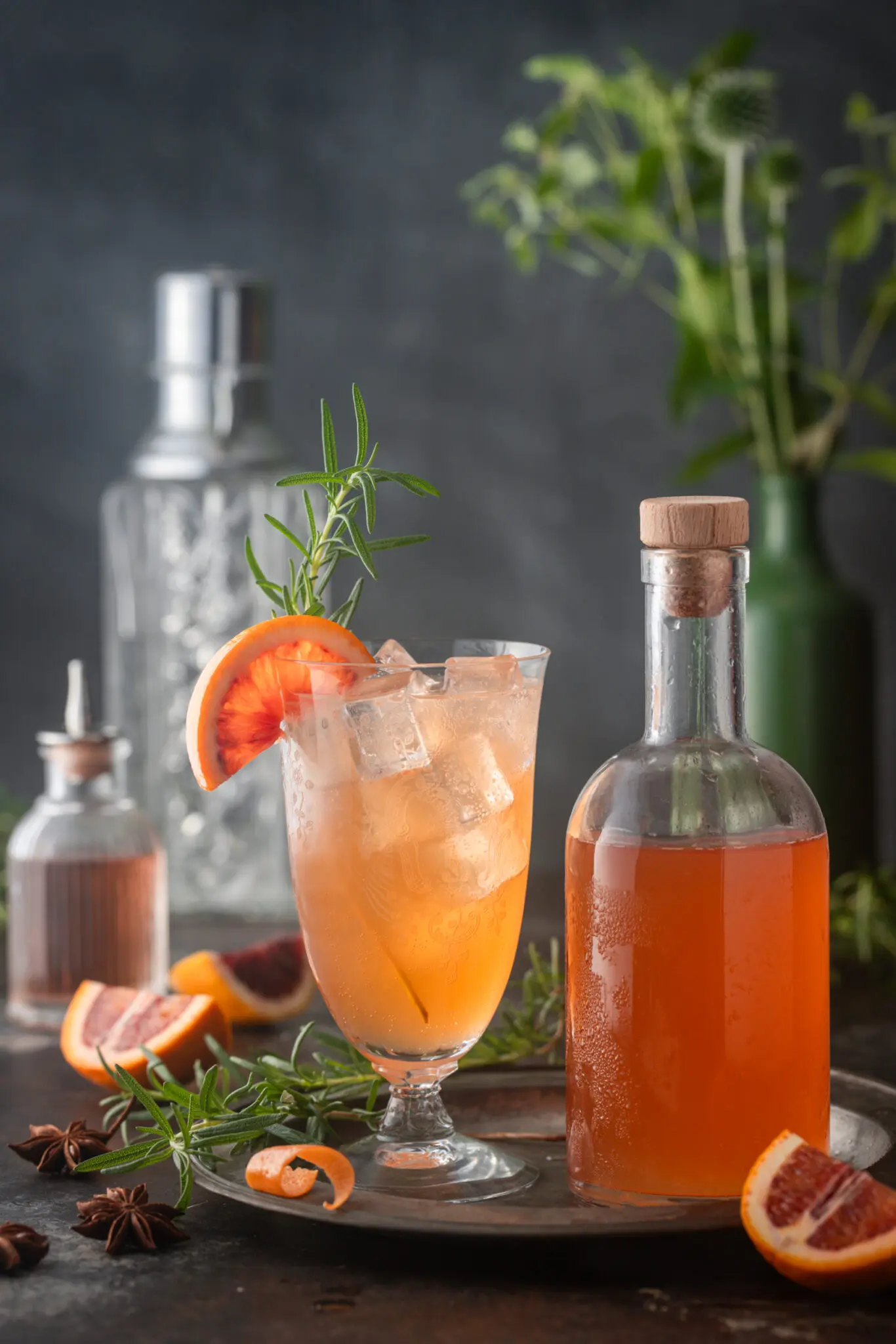
When I (Matt) was a kid, I wanted to grow up to be a mad scientist. You read that right. Not a regular scientist, mind, but specifically a mad scientist. I grew up on a diet of black-and-white movie serials — such as Buck Rogers and King of the Rocket Men — bafflingly broadcast on Saturday morning BBC children’s TV schedules in the late 1970s and early 80s and each containing a resident mad scientist. There was something about the role that appealed. Was it the bubbling bunsen burners? The rakish lab coat? The crazy hair? Whatever the allure, I determined that that would be my life career.
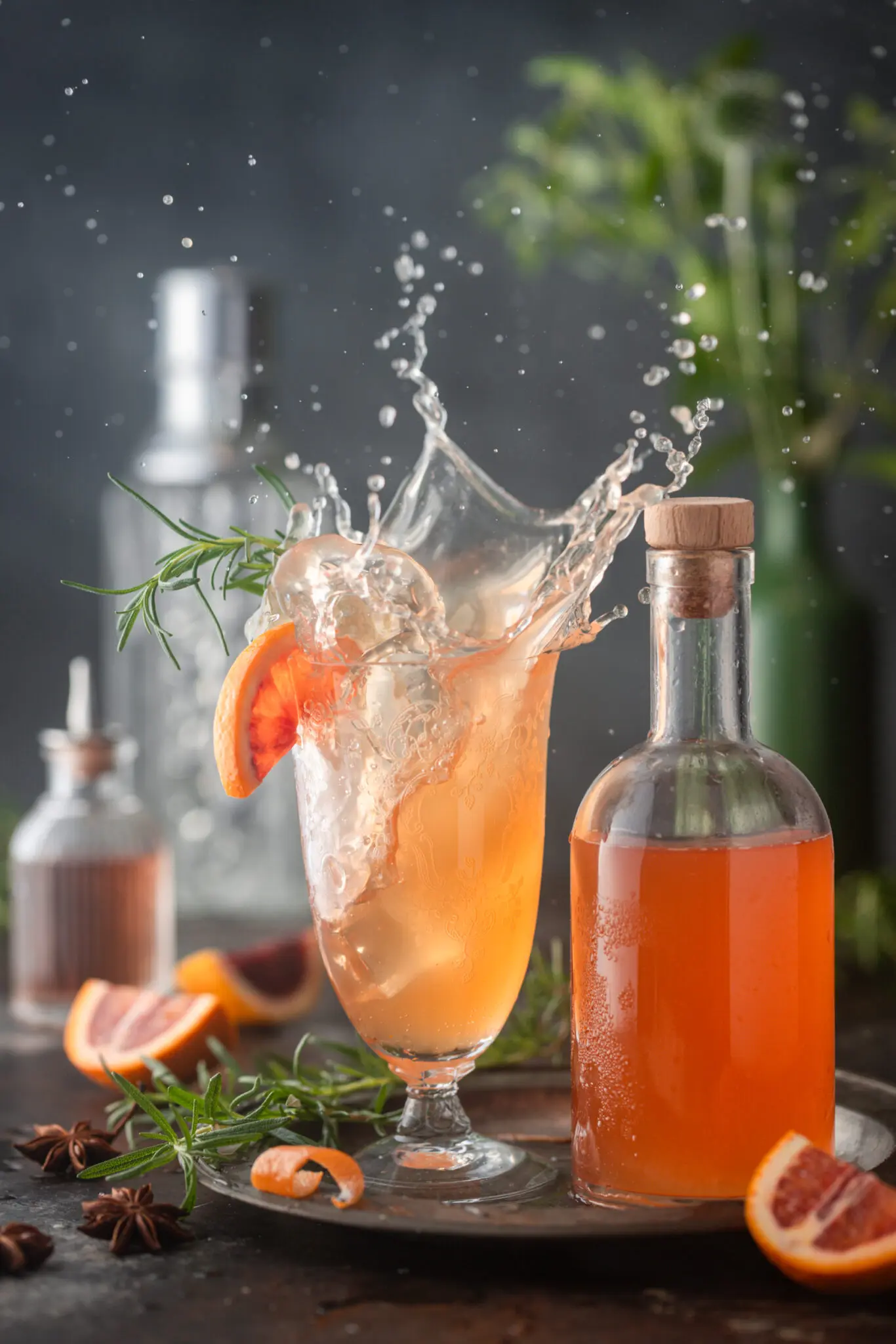
Most Christmases, I’d receive a chemistry set which I would fall upon with an evil cackle and a twirl of my non-existent mustache. But although I did dip my toe briefly into a chemistry career, that wasn’t to be my life path. And yet, I’ve never lost that love of throwing a bunch of chemicals together to make something fantastic, and of course I still occasionally sport the crazy hair. And after all, what is cooking but another form of chemistry?
So today I’d like you to join us in the lab as we giggle madly and whip up a batch of homemade tonic (or more accurately, Tonic Syrup, to be mixed with club soda and your spirit of choice). Our version is based on a recipe that was first developed by mixologist Kevin Ludwig, which then went through a veritable hot-potato game of variations by several talented cocktail enthusiasts including Jeffrey Morganthaler, Jennifer McLagan and David Lebowitz.
The basic recipe (which is both simple and delicious), contains quinine (cinchona bark), citric acid, limes and lemongrass. But Nerds gotta nerd, so we made a few additions which we feel add depth and complexity. The end result is, in our minds, the perfect mix of sour, sweet, bitter and floral.
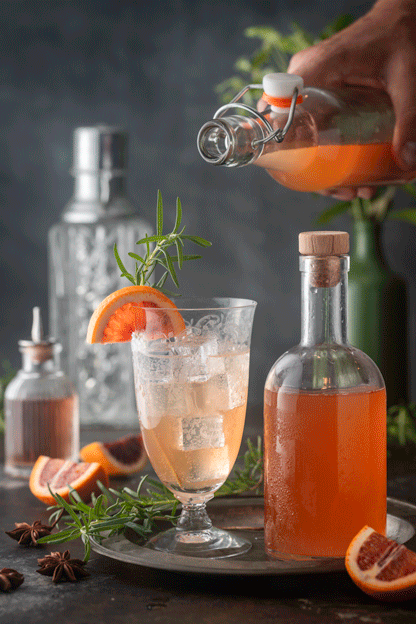
Is tonic water really a tonic?
The active ingredient in tonic water is the bitter chemical quinine, found in cinchona bark. Cinchona itself is a genus of plants growing primarily around the Andes in South America, and its bark has been used historically to treat malaria and other fevers. The British in colonial India were the first to combine the bitter tonic with gin to make it more palatable. (Note: you can combine most things with gin to make them more palatable.) Nowadays, commercial tonic water still uses quinine as a flavoring, but at quantities much too low for medicinal purposes. So you can claim that gin-and-tonic for health reasons if you like, but battling malaria is unlikely to be one of its benefits.
Most commercial tonics, even the fancy ones, lean heavily into sweetness, often with a slight citrusy tang and a mild bitter finish. It’s tasty stuff, but we wanted something with a little more punch (and without the high-fructose corn syrup and preservatives like sodium benzoate). You’ll notice that our version is not clear. In fact, we used blood oranges to add a beautiful blush to the the color. If you want a lighter colored tonic, stick with lemons and limes, instead of the mix of citrus we used.
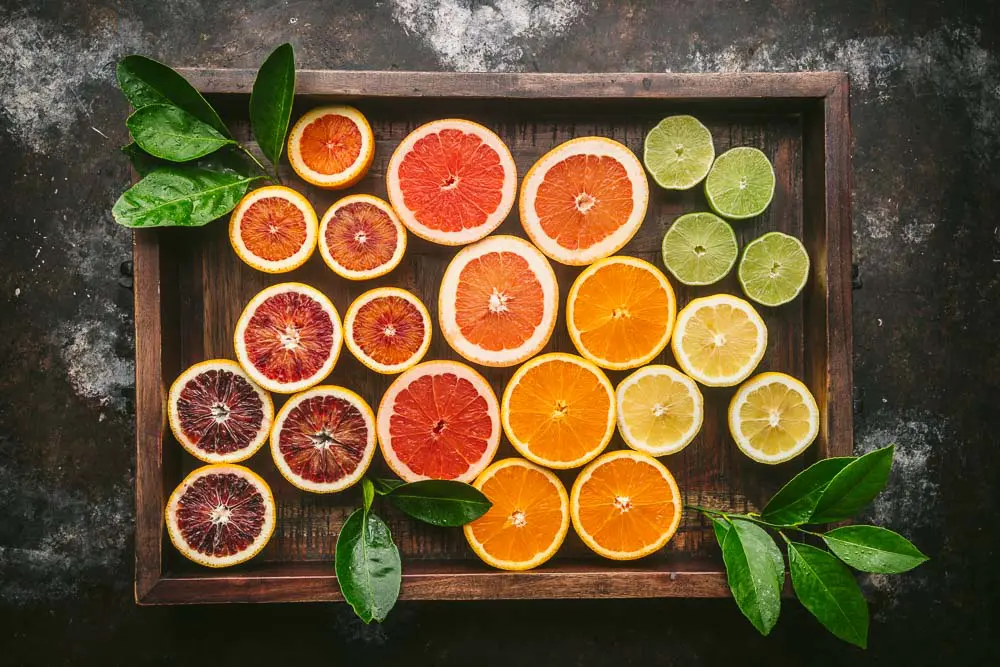
This version of homemade tonic is effectively a concentrate, mixed at pouring time with club soda to dilute it and add effervescence. FDA regulations prevent us from claiming that it’s healthier, but we like to think, at least, that it’s a more authentic flavored mixer than the commercial variety.
Tonic Ingredients and FLAVOR NOTES
The key bitter flavoring in tonic is the cinchona bark discussed above. We found cinchona at Amazon (the 8oz bag will serve for at least 8 batches of this recipe) but you may have a good local source such as a drinks supply store. You’ll also need powdered citric acid. Citric acid is the same acid found in lemon juice, but it’s concentrated and shelf-stable, which helps to balance out the sweetness and helps the tonic last longer in the refrigerator (it will keep for months, if you can make it last that long).
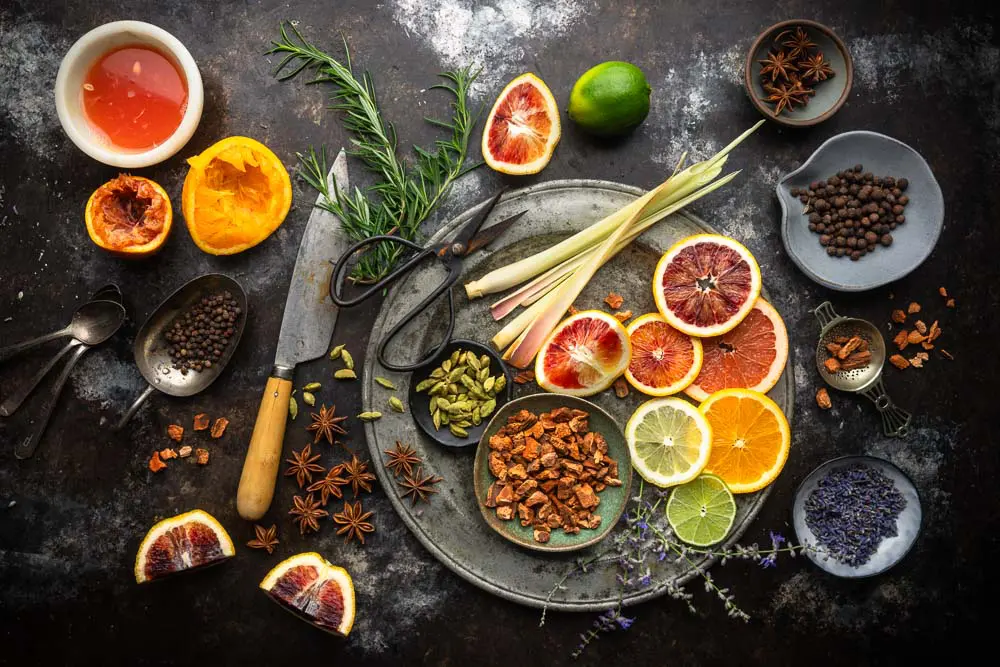
We should note that you by no means have to include every single ingredient in your version, but each adds a flavor note that we enjoyed. Instead of just the traditional limes, we added a mix of citrus (blood orange, pink grapefruit, lemon and lime). Blood orange was mostly for its gorgeous color, so feel free to sub regular oranges. We wanted some warm, spicy flavors, so we added star anise, black pepper, and allspice. For herbal and floral notes, a little fresh rosemary, green cardamom and dried lavender. Of course, it wouldn’t be tonic without lemongrass and quinine (cinchona bark). You should be able to find most of the ingredients in a regular grocery store or asian market and, of course, the internet is your friend when it comes to the harder-to-source elements.
The recipe is very customizable and you could absolutely make it with just cinchona, lemongrass, and citric acid. So if you don’t have some of these ingredients, it’s okay! Your tonic will still be delicious. Feel free to play with any other flavors you have in your pantry — try fresh thyme or sage from the herb garden; juniper berries, coriander or fennel seed or bay leaf from the spice rack.
crafting your homemade Tonic

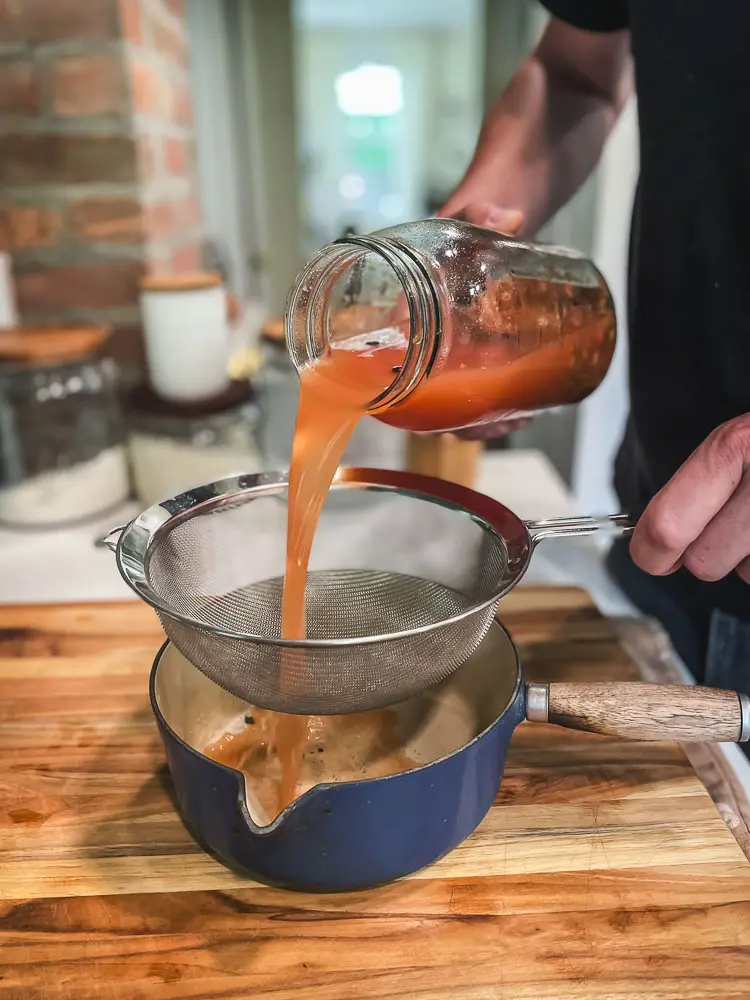
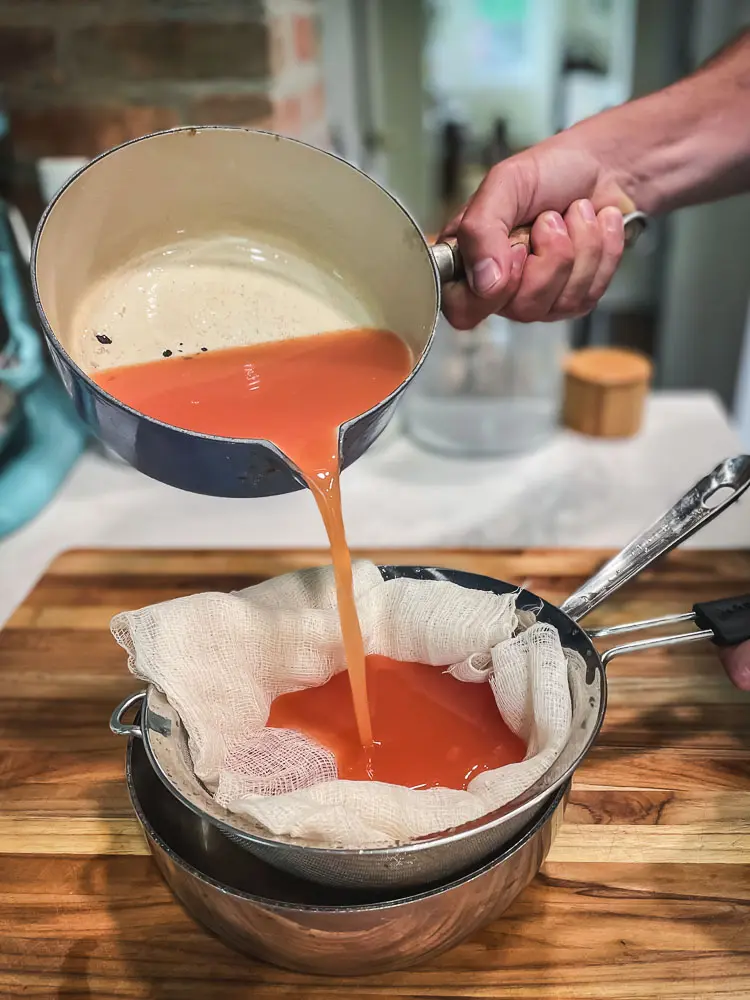
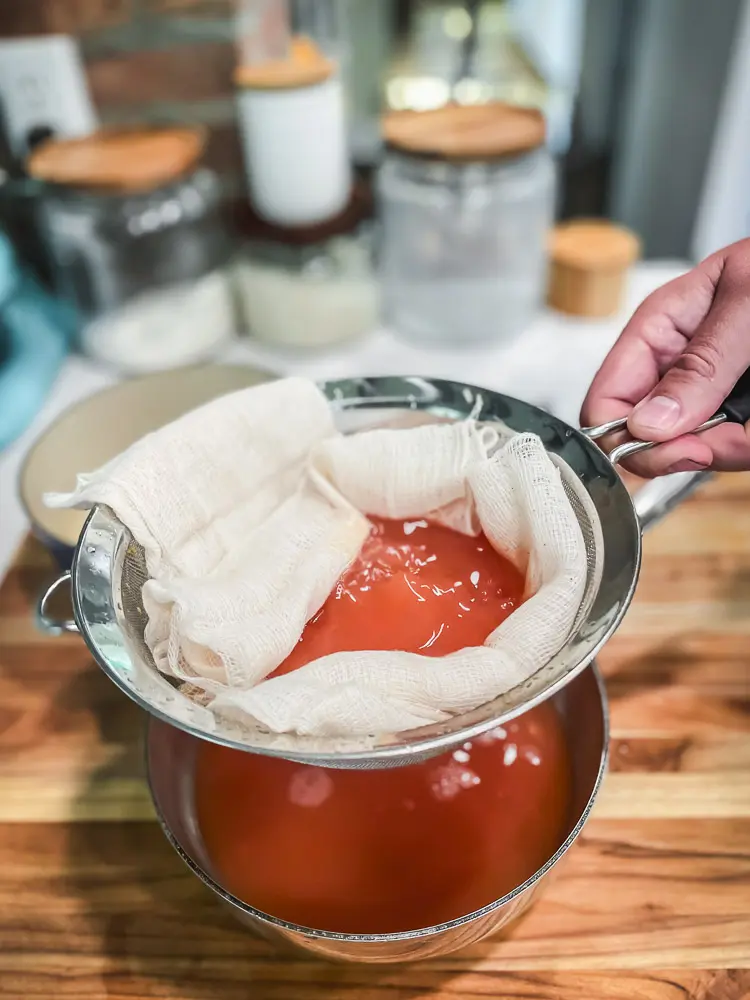
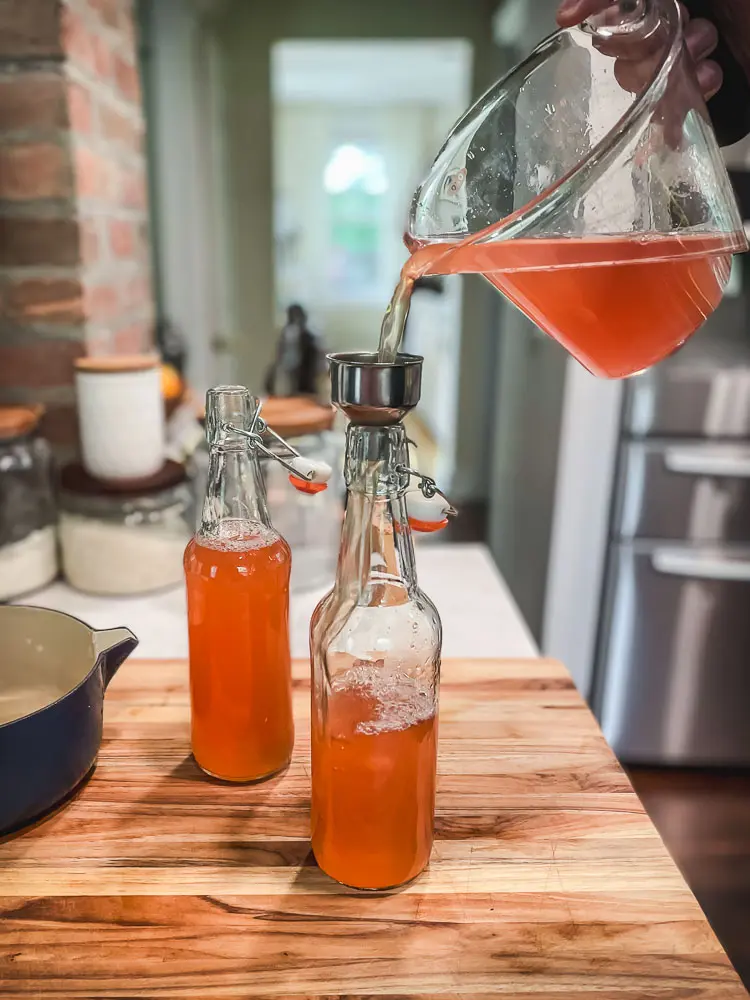
NOTE: Make sure you use a non-reactive saucepan as this is a very acidic mixture (So stainless steel, glass, or glazed ceramic is what you want. Avoid aluminum, un-lined copper and iron cookware).
Once you have your ingredients assembled and prepared, the process is simple. Use a sharp vegetable peeler to remove the rind of all the fruit (you can also use a microplane zester to grate it if you like). Add all the peels to a pot filled with one quart of cold water. Juice the fruit and add that as well (don’t worry about pits, it will all get filtered). You should end up with about 1 cup of juice in total. NOTE: If you use only lemons and/or limes, reduce juice to 3/4 of a cup to prevent the mix from being too tart.
Add all the rest of the ingredients (except for the sugar syrup) and bring it to a boil. Lower the heat to a simmer, cover, but leave it a little ajar so steam can escape. Let it simmer for 15 minutes, then turn off the heat, uncover it, and let it cool to room temperature. Pour the liquid and all the flavorings into a glass container with a sealable lid and refrigerate it for a couple of days. Give the jar a shake once or twice a day to get the most out of the infusion.
Next, make the sugar syrup by adding the sugar and water to a small saucepan and heat it, stirring occasionally, until it fully dissolves. Allow it to cool to room temperature. NOTE: You can make the sugar syrup up to a week in advance and keep it chilled in the refrigerator in a sealed container. You won’t need to use it until the tonic is ready to strain.
When the infusion is ready, place a mesh strainer over a large bowl and pour the tonic through it. Discard the solids. Then line the strainer with several layers of cheese cloth (you can also use a clean tea towel or coffee filters) and slowly pour the liquid through, back into the pot. If using the tea towel or filters, you will need to have some patience because it will drain quite slowly. Once the tonic is filtered, stir in the sugar syrup (if your syrup is very cold, straight from the refrigerator, it will take a bit of stirring to combine). Taste the tonic and adjust the sweetness, if desired. Transfer the tonic into clean glass bottles or jars, and refrigerate until you’re ready to use it.
Homemade tonic syrup will keep for several months in the refrigerator (though open the jars every so often to allow any trapped gasses to escape).
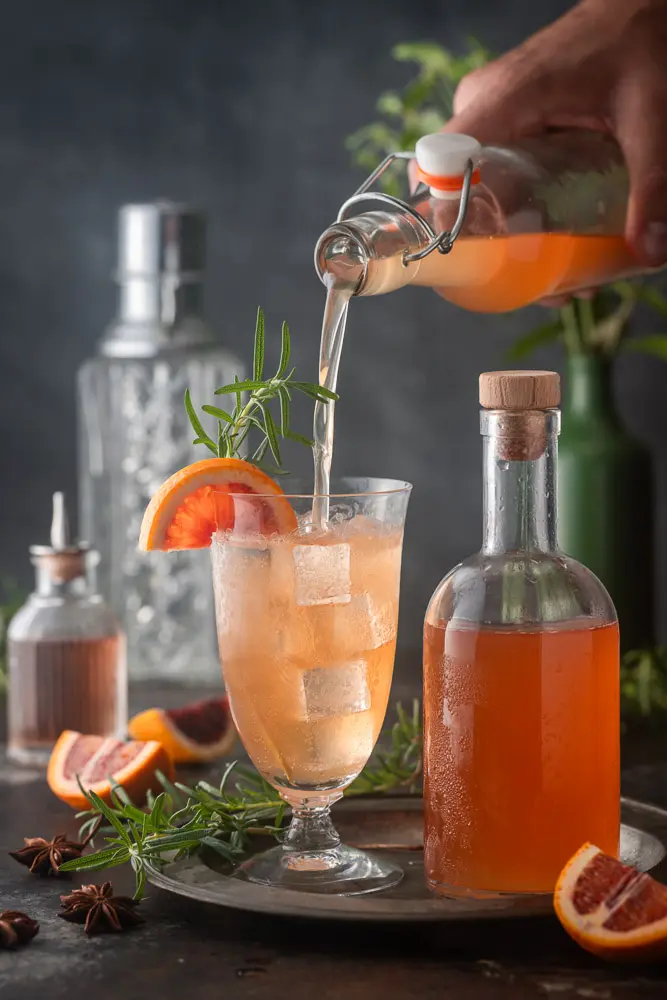
HOW TO USE homemade TONIC WATER SYRUP
Find our recipe below for a Gin (or Vodka) Tonic, and enjoy it as a refreshing chilled summer drink. Garnish it with a citrus wedge and a sprig of rosemary if you want. If you like a sweeter drink, add a little more syrup, until it tastes right to you.
If you’re feeling cheeky, try using bourbon instead. It tastes like a delicious and complex Old Fashioned. We loved it. The syrup is also flavorful and balanced enough that it makes a delicious mocktail, no spirits needed.
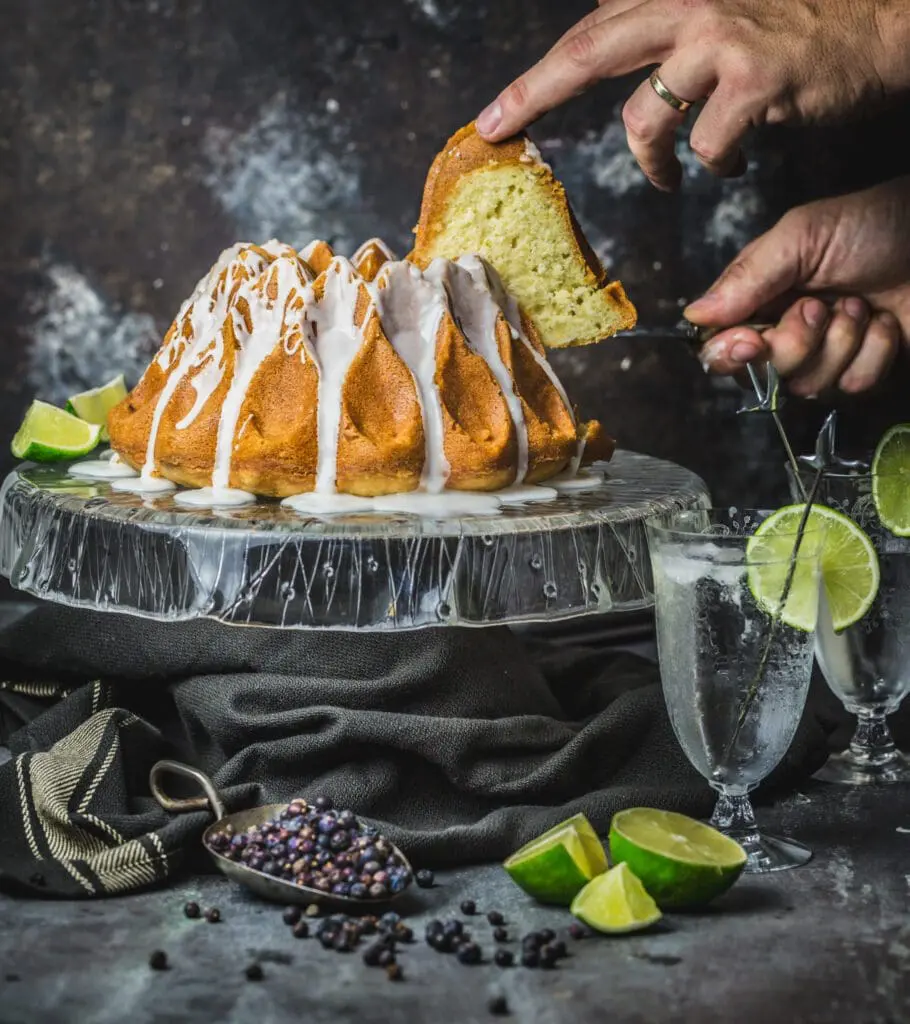

You can also use this concentrate as a flavoring for Gin-and-Tonic Pound Cake! You’ll find that recipe in Cork and Knife, our guide for cooking with alcohol.
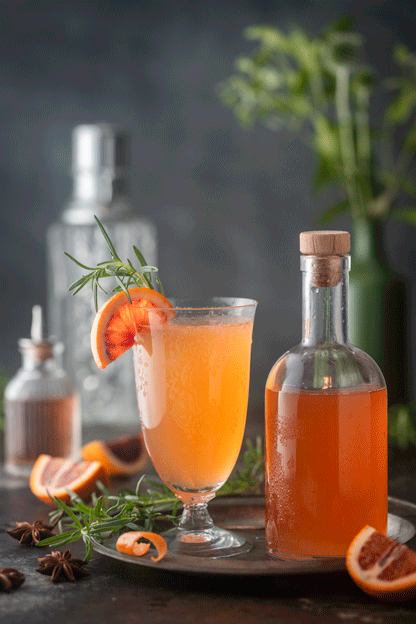
Whether you’re a mad scientist, a normal scientist, or just someone who likes mixing stuff together in the kitchen, this is a great homemade tonic recipe and we hope you have fun with it. Nothing in ze vorld vill stop us now! A ha ha ha! … Er, I mean “Cheers!”
Homemade Tonic Water Syrup
Ingredients
- 1 quart water (1L)
- 1 pink grapefruit
- 1 blood orange or regular orange
- 1 lemon
- 1 lime
- 2 1/2 ounces chopped lemongrass (use the bottom 2/3rds of the stalks, trimming off the root and any dry outer layers) 75g (about 5 -8 stalks, depending on size)
- 1 3-inch fresh rosemary sprig
- 3 tablespoons citric acid 33g
- 1/4 cup chopped cinchona bark, lightly crushed 25g
- 6 allspice berries whole
- 5 green cardamom pods lightly crushed
- 2 star anise pods whole
- 1 tablespoon dried lavender
- 1 teaspoon coarse sea or kosher salt
- 1 teaspoon whole black peppercorns whole
For the Simple Syrup
- 1 1/2 cups sugar
- 1 cup water
Instructions
- Peel strips of zest from the citrus fruits using a sharp vegetable peeler (or grate with a microplane). Try to remove just the skin, not the white pith. Add the zest to a medium-sized non-reactive saucepan. Cut the citrus in half and juice directly into the saucepan.*
- Add the water, lemongrass, rosemary, citric acid, cinchona bark, allspice, cardamom, star anise, lavender, salt, and black peppercorns. Bring the mixture to a boil on high heat, then reduce to a simmer. Cover, leaving the lid slightly ajar, and simmer gently for 15 minutes. Remove from heat, uncover, cool to room temperature.
- Pour both liquids and solids into a clean, sealable container, such as a large screw-top jar, and refrigerate for 2 days, shaking it gently a couple of times a day.
- When ready to bottle, make the simple syrup by adding the sugar and water into a medium saucepan. Heat on medium-high, stirring often, until sugar dissolves. Remove from heat and cool to room temperature. (Can be made up to a week ahead and refrigerated).
- Strain the tonic liquid through a fine mesh strainer into a bowl or large measuring cup. Discard the solids. Strain the mixture again, this time through a strainer lined with several layers of cheesecloth, a clean kitchen towel, or a coffee filter. (If using a towel or coffee filter, it will drain slowly, so be patient.)
- Add the cooled sugar syrup, and stir to combine. Carefully pour into clean bottles or screw-top jars and refrigerate until ready to use.
- Storage: The tonic water can be kept for several months in the refrigerator. Don’t tighten the lid, as the tonic water can ferment a little and you want any gas to be able to escape.
TO MAKE ONE GIN (OR VODKA) TONIC
- Combine 2 ounces Homemade Tonic Water Syrup with 2 ounces vodka or gin, and 3 to 4 ounces club soda. Add ice and gently stir to combine. (Use a little more or less syrup to adjust the sweetness of your drink). Garnish with a citrus wedge and a rosemary sprig.
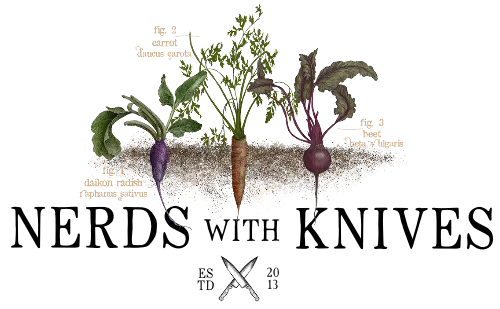

Okay just leaving a review of the reviews. It is unhelpful to leave any rating without a comment to explain ones reasoning for the rating, but just plane mean spirited when leaving one and two stars with no comment.
I never realized making tonic water at home could be so easy! I love that I can control the flavors and sweetness. Can’t wait to try this recipe and mix up some refreshing cocktails!
Love this recipe! I triple, and only add juice of one lemon and lime. It lasts for a long time in the fridge. I used to only use it with Gin, but lately switched to tequila and love it even more.
So glad you like it! I definitely have to try it with tequila next time 🙂
So glad you like it! I definitely have to try it with tequila next time 🙂
This homemade tonic water recipe is fantastic! I love how you included natural ingredients and gave tips on how to customize the flavor. Can’t wait to try it with my favorite gin for a refreshing summer drink! Thanks for sharing!
I never knew making homemade tonic water could be so simple! The recipe sounds delicious and refreshing. I can’t wait to try it out with some fresh herbs and citrus. Thanks for sharing!
This recipe for homemade tonic water is amazing! I adore how you provided advice on how to alter the flavor and used natural ingredients. I’m eager to try it as a cool summer beverage with my favorite gin! I appreciate you sharing!
I love the mad scientist vibe in this post — it makes the whole tonic syrup process sound like a fun experiment! Can’t wait to try this at home, especially with the mix of citrus and spices. The tip about using blood orange for color is genius!
Estaba buscando una app de entretenimiento y encontré MagisTV, que me ha funcionado de maravilla. La instalación fue rápida, y la app ofrece miles de canales sin ningún tipo de suscripción. Ideal para ver televisión desde el celular o en una pantalla grande.
Leaving low ratings without any explanation doesn’t help anyone. If you’re going to rate poorly, at least share why. Otherwise, it just feels unfair.
What a fantastic and detailed guide! I love learning the process behind ingredients we usually just buy. Great post!
This is our go to recipe now! Will not be buying tonic water anymore. Tastes like what you buy, but more flavorful and you know what’s in it. Pairs with our soda stream to make for a more eco friendly option than buying cans. I did powdered bark instead because it’s what I could fine and still worked well…just was darker in color and more difficult to strain.
Hi Emily, so glad you like it! And thanks so much for rating and reviewing :).
Now I got realized why the problems where occuring during this amazing recepie btw such a greatful blog post.